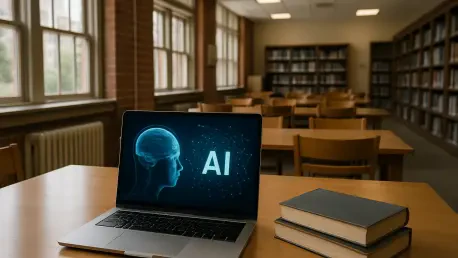I’m thrilled to sit down with Camille Faivre, a renowned education expert with a deep focus on education management. In the ever-evolving, post-pandemic landscape of higher education, Camille has been at the forefront, guiding institutions in crafting and rolling out open and e-learning programs. Today, we’ll dive into the transformative role of artificial intelligence in college operations, exploring how AI tools are reshaping administrative functions, the critical considerations for their adoption, and the ethical and environmental challenges they present. Our conversation promises to unpack the complexities of responsibly integrating AI into higher education, offering valuable insights for leaders navigating this dynamic space.
How has the landscape of AI tools in higher education evolved recently, and what kinds of solutions are institutions exploring for their operations?
The landscape of AI in higher education has seen explosive growth, especially in recent years. We’re witnessing a surge of tools tailored for various functions, from admissions chatbots that handle prospective student inquiries 24/7 to retention analytics that help identify at-risk students early on. There are also tutoring systems powered by AI to personalize learning experiences and operational software for streamlining administrative tasks. The market is incredibly crowded right now, almost flooded with options, as vendors rush to meet the demand. Institutions are exploring these solutions to boost efficiency, but the sheer volume of choices can be overwhelming, making it critical to focus on specific needs rather than chasing every shiny new tool.
What approach should college leaders take to determine whether an AI solution is truly necessary for a specific challenge they’re facing?
College leaders need to start with a clear-eyed assessment of the problem at hand. They should ask themselves how AI might solve this issue better than existing tools or processes. It’s about stepping back and evaluating if the current team or traditional methods can handle the task just as effectively. A practical approach is to map out the problem, identify desired outcomes, and then see if AI offers a unique advantage—like speed, scale, or personalization—that other solutions can’t match. Too often, there’s a rush to adopt AI because it’s trendy, but leaders must prioritize necessity over novelty to avoid wasting resources.
Can you share an example of a common higher education problem that might not actually require an AI solution?
Absolutely. Take something like scheduling office hours for faculty or managing room bookings for events. These are logistical challenges that can often be handled efficiently with existing software or even manual coordination by staff. Implementing an AI tool for such a straightforward task might overcomplicate things, adding unnecessary costs and training time when a simpler, tried-and-true system already works well. The key is recognizing when human judgment or basic automation is sufficient without the complexity of AI.
When considering the purchase of an AI tool, how crucial is it to align the technology with a specific purpose or use case?
It’s absolutely essential. AI tools perform best when they’re purpose-built for a specific function. If you try to adapt a general AI model to a task it wasn’t designed for, the results are often subpar. For instance, using a generic chatbot for nuanced admissions queries without tailoring it to your institution’s policies can lead to inaccurate responses and frustrated students. Leaders should define their use case upfront—whether it’s improving student retention or automating repetitive tasks—and then seek out tools designed explicitly for that purpose. This alignment ensures better outcomes and a smoother integration.
What should administrators keep in mind about the end users when selecting an AI tool for their campus?
Administrators need to think deeply about who will interact with the tool—whether it’s staff, students, or faculty—and how user-friendly it is for that audience. For example, if an AI system for admissions is too complex for non-tech-savvy staff to navigate, adoption will be low, and the investment wasted. It’s also important to consider the training required and whether users feel comfortable with the technology. Engaging end users early, perhaps through pilot testing or feedback sessions, can reveal potential hurdles and ensure the tool meets their actual needs rather than just looking good on paper.
What are some of the privacy concerns that colleges should be vigilant about when adopting AI technologies?
Privacy is a huge concern with AI, especially since these tools often handle sensitive data like student records or personal information. Colleges must ensure that any AI system complies with regulations like FERPA in the U.S., which protects student privacy. They should scrutinize how data is stored, who has access to it, and whether it’s being shared with third parties. There’s also the risk of data breaches, so robust security measures are non-negotiable. Transparency with users about how their data is used is critical to maintaining trust, especially when students or staff might not fully understand the technology behind the scenes.
How can institutions assess the readiness and quality of AI features before fully committing to a tool?
Assessing readiness starts with asking vendors tough questions about the development stage of their AI features. Is the tool fully operational, or is it still in beta testing? Institutions should request detailed demos and case studies showing real-world performance, not just marketing promises. It’s also wise to run pilot programs on a small scale to test the tool in their specific environment. For instance, if it’s a chatbot, monitor its responses for accuracy and relevance over a set period. This hands-on evaluation helps determine if the AI is truly ready for widespread use or if it needs more refinement.
What ethical and legal considerations should colleges prioritize when integrating AI into their operations?
Ethically, colleges need to consider how AI impacts staff roles and workflows. Will it displace jobs, or can it be positioned as a supportive tool? Legally, they must review existing contracts, like union agreements, to ensure AI adoption doesn’t violate terms related to technology use or employee rights. Data privacy laws are another major concern—knowing where data is stored and how it’s protected is crucial. There’s also an ethical duty to avoid bias in AI systems, especially in areas like admissions, where algorithms could unintentionally perpetuate inequities if not carefully monitored and adjusted.
How does the environmental impact of AI factor into the decision-making process for colleges, and what challenges do they face in this area?
The environmental impact of AI is a growing concern that colleges can’t ignore. AI systems, especially those involving large-scale data processing, consume significantly more energy than traditional tools—sometimes up to 30 times more for tasks like search functions. Beyond energy, there’s the issue of water usage for cooling data centers, which can strain local resources. The challenge for colleges is balancing the benefits of AI with these costs, especially since most don’t have direct control over the infrastructure. While solutions aren’t fully developed yet, institutions can start by prioritizing energy-efficient tools and advocating for sustainable practices from vendors.
Why is transparency so vital when using AI tools like chatbots in interactions with students?
Transparency builds trust, plain and simple. Students have a right to know when they’re interacting with AI rather than a human, especially in sensitive contexts like admissions or academic support. If they’re unaware, it can feel deceptive, eroding confidence in the institution. Clear labeling—like naming a chatbot something obvious to signal its nature—and consistent communication about its role ensure students understand the interaction. This openness also helps set realistic expectations about the tool’s capabilities, preventing frustration if responses aren’t as nuanced as a human’s might be.
What is your forecast for the future of AI in higher education, particularly in terms of balancing innovation with responsibility?
I’m optimistic about AI’s potential to transform higher education, from personalizing learning to streamlining operations. However, the future hinges on striking a balance between innovation and responsibility. I foresee AI becoming more embedded in everyday campus functions, but only if institutions prioritize ethical frameworks, robust privacy protections, and sustainable practices. We’ll likely see advancements in AI efficiency, reducing environmental impacts, and more tailored tools for specific educational needs. The key will be continuous evaluation and adaptation—AI evolves rapidly, so colleges must stay agile, regularly reassessing tools and policies to ensure they serve students and staff without unintended consequences.








